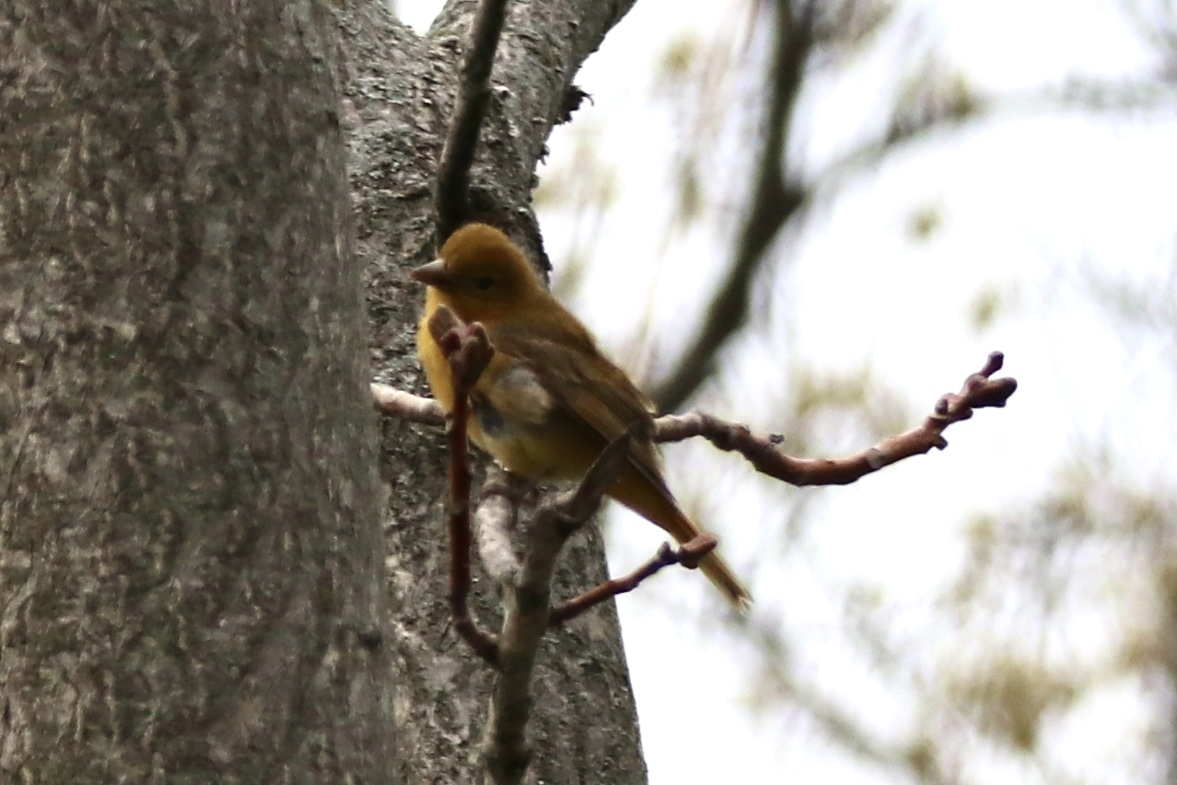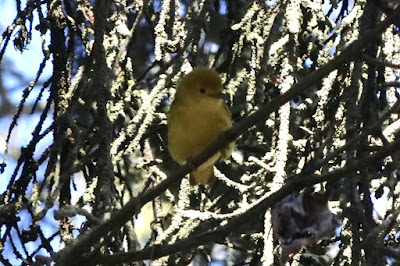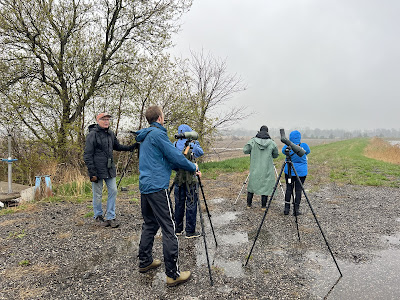We just finished our four day trip to Point Pelee National Park with the addition of a rare and unexpected Bell’s Vireo before heading out to Rondeau Provincial Park for the remainder of our migration week. We saw 132 species in four days and I added 31 species to the Big Year List.
I kind of cheated and took a day trip to Rondeau on my own, the previous week.There was a White-faced Ibis and Henslow’s Sparrow there and I knew I couldn’t miss either. I started with the ibis on the Erieau Marsh Trail, on a very windy, chilly and wet morning. These guys are much easier to see in Texas, but not during a Canada Big Year, so I braved the stiff winds and got my photo and quickly headed back to the car and my seat warmers and still warm coffee.
Next up was the Henslow’s Sparrow on the Marsh Trail in Rondeau Provincial Park. By the time I got there the rain had let up, the winds had died down and target sparrow was nowhere to be seen. But there were a friendly group of birders hungry for this rare sighting, so the time was enjoyable while we awaited its return. Eventually it did show up and I was able to spot it for a fellow birder and get my own photos of yet another Canadian Lifer, species 426 for Canada.
A week later we were on the road to Point Pelee. We arrived late Monday morning and you need to know two things when you first start birding in southern Ontario:
1: Point Pelee National Park is the place to be in May, if your want to see the most warblers and other spring migrants.
2: If you get to the park after 7:00am you may not get a parking spot near the Visitor Centre.
We took heed of step one, but on this day, neglected step two, as we left from Brantford just before 7:00am. We weren’t in a hurry and planned a later arrival on Day One, since we would be birding down here all week. We started at Hillman Marsh Conservation Area, but all we were seeing were Dunlin, aside from the cutest ever baby Kildeer on a nearby side road.

So we made our way to the National Park and zipped right in with our swipe pass. It’s a bit of a drive down to the Visitor Centre parking lot, and once we did get close, the road was blocked and we were told it was full. What else should we have expected at 10:00am? We were directed to an overflow lot that was also full, and told to turn around and perhaps circle back and hope a spot came available. Parking at Pelee is like getting a good parking spot in Manhattan. No one wants to give it up. However, as we were getting close to the point of no return, a car miraculously pulled out in front of us and we were able to park in the overflow lot, not that much further from the main lot, and it was a good spot to return to for lunch.
We made our way directly to the Woodland Trail, behind the Visitor Centre, though I did stop for a coffee and a long look at a frosted donut. I just took the coffee and Sue and I headed to the trail. It didn’t take long to be seeing birds. First up, was a White-eyed Vireo, not new for the year, but a very nice bird to start the list. Point Pelee has a 100 bird challenge and once you reach that number, you can present your list at the Visitor Centre and receive a commemorative pin. I got mine on the third morning and promptly lost it. I did go back the last morning we were there and someone had returned it and I safely stowed it in a pocket this time.
Another thing you need to know about Point Pelee is that the cell service is not good at the best of times and nonexistent most of the time. That means word of mouth and looking for large congregations of birders is the best way to discover rare sightings in the park. Once we made it down to The Tip, that’s where the real action started. With this being the first festival after a two year break due to some kind of Global Pandemic, birders were eager to get out and share the excitement of finding spring warblers with others they hadn’t seen since 2019.
Hundreds of birders were gathered at the tip and every time a novel bird landed, we all flocked in the same direction, with the same migrating instinct the birds exhibit as they head from places far south to find their mates and nesting grounds. The birds, having just travelled across the lake after, in some cases, thousands of miles in the air, were often so tired they were just sitting on the ground or hopping around on the rocks at the edge of Lake Erie. The tip of Point Pelee is is the furthest southern point in Canada and is the first land the birds see as they finish their lake crossing.
Over the next few days we chased all the rare warbles that were being found, with, at first, less than stellar results. But finally, we started catching up with some of the tougher spring warblers, including Cerulean, Hooded and the one we’ve all been waiting for, the Canada Warbler.
The beautiful Cerulean Warbler, one of the few non-yellow Warblers:
Hooded Warbler:
Canada Warbler, Many a Birder’s Personal Favorite:
I had been unsuccessfully chasing reports of rare spring migrants, and even once had to text and call Sue to race back to the park for a reported Kirtland’s Warbler. She came back, a little frustrated because she was driving to a flower seller she wanted to visit outside the park, and had to pull over to read my texts and answer the phone. I walked while she drove back and eventually we got to the reported spot, but the Kirtland’s was nowhere to be found. On the upside, there was a pair of cuckoos,(well to be honest there were more than a pair!).
Yellow-billed Cuckoo:
Black-billed Cuckoo:
On the last two days we where to be at Pelee, things even got better. We were seeing Woodcock, Wood Thrush, Wilson’s Warbler and even a tired Least Bittern sitting in a tree at the Tip. Then we ran into friends of ours, Ellen and Jerry, who we bird with in Brantford, and things really got exciting. Ellen had found a Mourning Warbler, one of the stealthy and tougher birds to see, and Sue and I were searching for it, when Ellen called to let us know she and Jerry had one right in front of them. We got back in the car and drove quickly to the main parking lot and Ellen guided us to the correct spot and, yes there it was! As we were chatting, Ellen mentioned that she had heard a Bell’s Vireo was being seen the West Beach. That is indeed a rare bird for Canada and one I had only seen once or twice in the US.
We drove and walked quickly over to the West Beach trail to the shores of Lake Erie, where, in a grove of bushes a large group of excited birders were searching for the bird. Were we too late? Did I miss another Pelee rarity? My fears were put to rest when the bird finally popped out into the open and I even was able to get some photos. Thanks to Ellen and Jerry I had species 335 and 336 for the year!
Mourning Warbler:
Least Bittern:
Wilson’s Warbler:
Bell’s Vireo:
Wood Thrush:
American Woodcock:
The final and maybe most exciting bird for the Point Pelee Park List, before we headed off to Rondeau Provincial Park, was a Mississippi Kite. Sue was attending a shore bird talk by the illustrious Gene Iron, and I was birding on my own for a couple of hours. I ran into one of the bird hike guides and he mentioned how good the winds were for hawks and especially Mississippi Kites that morning. So, as I walked and birded, I kept my eyes on the sky and as I was walking back to the Visitor Centre to meet up with Sue, a Turkey Vulture caught my eye, and in close pursuit behind it, was a smaller bird. I got my binoculars on it and could see it was very light underneath with dark wings and a small white head. I had one of the most sought after birds for the park, and species 337 for the year.
We left Pelee having seen over 120 species in just 4 days, which qualified us for commemorative 100 species pins they were handing out, which was cool. We had picked them up the previous day and I promptly lost mine, having pinned it to my camera strap. Just before we were headed to the car to drive out to Rondeau, we stopped by the Visitor Centre and I told my story of having lost the pin. The nice woman behind the counter, smiled and and reached onto a shelf and handed me a pin that had been found on the path outside the door and handed in. A nice way to end our trip to one of the best Spring Migration hotspots in all of North America.
Mississippi Kite:
(I didn’t get photos of the one in Pelee, but I did take these in Texas a few years ago)























































